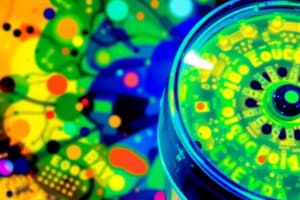Podcast
Questions and Answers
What is the primary function of a centrifuge in a molecular biology laboratory?
What is the primary function of a centrifuge in a molecular biology laboratory?
- To separate and purify mixtures (correct)
- To store biological samples at low temperatures
- To transfer small quantities of liquid
- To maintain optimal growth conditions for cultures
In which speed range does a micro centrifuge typically operate?
In which speed range does a micro centrifuge typically operate?
- 100 rpm to 500 rpm
- 1,000 rpm to 3,000 rpm
- 10,000 rpm to 15,000 rpm
- 500 rpm to 13,300 rpm (correct)
What is the most common size of Eppendorf tubes used in laboratories?
What is the most common size of Eppendorf tubes used in laboratories?
- 1.0 ml
- 2.0 ml
- 0.5 ml
- 1.5 ml (correct)
Which condition is NOT typically maintained by incubators in a microbiology lab?
Which condition is NOT typically maintained by incubators in a microbiology lab?
What temperature range can laboratory freezers maintain for biological samples?
What temperature range can laboratory freezers maintain for biological samples?
What is the primary purpose of the thermal cycler in molecular biology?
What is the primary purpose of the thermal cycler in molecular biology?
Which temperature is typically used for the extension phase in the polymerase chain reaction (PCR)?
Which temperature is typically used for the extension phase in the polymerase chain reaction (PCR)?
In gel electrophoresis, what does the term 'anode' refer to?
In gel electrophoresis, what does the term 'anode' refer to?
What is the role of the fluorescent dye in UV transilluminators?
What is the role of the fluorescent dye in UV transilluminators?
During the denaturation phase of PCR, what happens to the template DNA?
During the denaturation phase of PCR, what happens to the template DNA?
Study Notes
Introduction
- Molecular biology is the study of the structure, function, and manipulation of macromolecules essential to life.
- Some major macromolecules include proteins and nucleic acids.
Centrifuge
- Separates substances by size, shape, density, viscosity, and rotor speed.
- Can be used to purify mixtures.
- Employs centrifugal force for separating particles.
- Operates on the principle of sedimentation due to gravitational force.
Microcentrifuge
- Extremely small in design, taking up little space.
- Uses small tube sizes, typically up to 2.0 ml.
- Has a speed range from 500 rpm to 13300 rpm.
- Useful for pelleting nucleic acids, pelleting proteins from solution, and microfiltration of small aqueous samples.
Micropipettes
- Transfer small liquid quantities, typically down to 0.1 uL.
- Used in various laboratories, including chemistry, biology, forensics, pharmaceuticals, and drug discovery.
Eppendorf Tubes
- Small capped plastic tubes.
- Commonly used in centrifuges and PCR apparatuses.
- Available in various volumes like 0.5 ml, 1.5 ml, 2 ml, with 1.5 ml being the most common.
Incubators
- Devices for growing and maintaining microbiological or cell cultures.
- Maintain optimal temperature, humidity, and atmospheric conditions like carbon dioxide and oxygen levels.
Freezers
- Cold cabinets that store biological samples at temperatures ranging from 10°C to -80°C.
- Used in laboratories, hospitals, blood banks, research facilities, and testing centers.
- Essential for preserving sensitive biological samples like DNA.
Thermal Cycler
- Amplifies segments of DNA through the polymerase chain reaction (PCR).
- Utilizes a chain reaction where a small DNA fragment serves as a template for primer production.
- Operates in three stages:
- Denaturation: Separates double-stranded DNA at 94°C.
- Annealing: Allows oligonucleotide primers to bind to the template at 54°C.
- Extension: Synthesizes new DNA strands using thermostable DNA polymerase at 72°C.
Electrophoresis Chamber
- Separates and analyzes macromolecules like DNA, RNA, and proteins based on size and charge.
- Employs an electric field to move molecules through a gel matrix.
- Positively charged molecules migrate toward the negatively charged cathode.
- Negatively charged molecules migrate toward the positively charged anode.
UV Transilluminator
- Used to visualize DNA or RNA separated by gel electrophoresis.
- The gel is stained with a fluorescent dye that binds to nucleic acids.
- Exposing the stained gel to a UVB light source causes the DNA/dye to fluoresce and become visible.
Studying That Suits You
Use AI to generate personalized quizzes and flashcards to suit your learning preferences.
Related Documents
Description
This quiz covers the fundamental techniques used in molecular biology, including the use of centrifuges, microcentrifuges, micropipettes, and Eppendorf tubes. Understand the principles and applications of these tools in studying macromolecules and conducting experiments in the laboratory.




